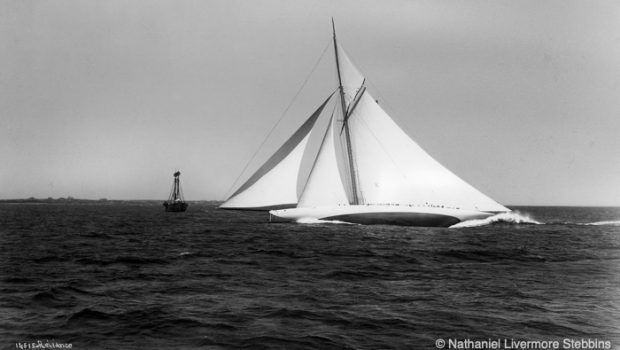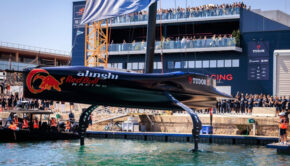Reliance: America’s Cup Beautiful Freak
Published on December 21st, 2020
The beautiful behemoth Reliance handily defended the America’s Cup in 1903, but her freakishly large size caused the contest’s rules on design to change after the race. British tea magnate Sir Thomas Lipton for the America’s Cup that year issued the challenge. He had already challenged America twice since 1899 for the Cup, and he would challenge twice again until 1930.
Lipton, a self-made millionaire, had built a chain of grocery stores in Britain and invented the tea bag. He loved yachting, and he hired Britain’s best yacht designers to build his challengers, all named Shamrock.
The New York Yacht Club, defender of the Cup, enlisted America’s best yacht designer, and one of the most innovative in history, Nathaniel Greene Herreshoff, or Captain Nat, born March 18, 1848. He and his brother J.B. founded the Herreshoff Manufacturing Company. They earned worldwide renown for their fast steam yachts, innovative torpedo boats and superbly crafted sailboats.
Captain Nat, then in his 50s, didn’t want to design the 1903 America’s Cup defender. His wife Clara was ill and he suffered from rheumatism. He also hadn’t gotten over the failure of his yacht Constitution to beat Columbia in the 1901 Cup trials. But the New York Yacht Club persisted. Captain Nat gave in. He would enjoy another 10 years of the ‘Herreshoff Era’ of racing, from 1890 to 1920.
Herreshoff launched Reliance at Bristol on April 12, 1903. She was the largest single-masted sailboat ever, at 143’, 9” with 16,160 sq. ft. of sails, weighing four tons. Her mast was as tall as a 20-story building. Her spinnaker pole was 84 feet long. It took a crew of 66 to sail her. And yet she was built for speed, so she was light and unstable.
The Reliance was a freak. A sailing freak. Like all racing yachts, she had one purpose and one purpose alone: to win the America’s Cup. Yachtsman Cornelius Vanderbilt defended the Reliance from its critics, “Call the boat a freak, anything you like, but we cannot handicap ourselves, even if our boat is only fit for the junk heap the day after the race.”
The challenge featured a series of five races in New York Harbor. Hundreds of thousands of spectators streamed into New York for the races, buying tickets on a fleet of excursion steamers. The race was more than a race. It was a matter of national pride.
Reliance won the first three races, the third so decisively that Shamrock III retired. Lipton, as always, lost graciously. Immediately after Reliance won the race, Herreshoff proposed the Universal rating rule to avoid such extreme, dangerous and expensive sailboats. The rule was then accepted.
Reliance went to the scrap heap in 1913. The Herreshoff Marine Museum in Bristol, built a one-sixth model of the Reliance.
Source: New England Historical Society









 We’ll keep your information safe.
We’ll keep your information safe.